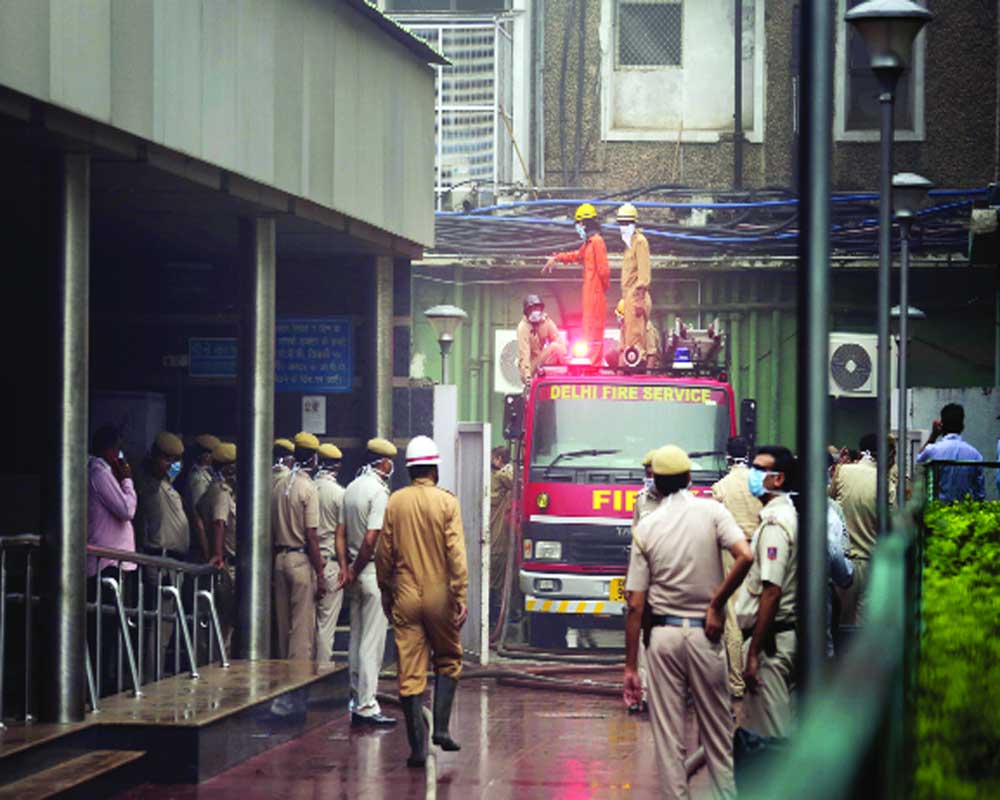Though lives were saved, poor compliance means years of precious research have been lost at the elite institution
The intensity of the massive blaze at the All India Institute of Medical Sciences (AIIMS), New Delhi, and the leaping fury with which it engulfed its floors in a matter of moments can be gauged from the fact that it took nearly three dozen fire tenders over eight long hours to be doused. Had not AIIMS been a prized institution, perhaps the emergency response wouldn’t have been activated with as much urgency and wilfulness but the fact remains that even the safety protocols at the most aware of places had not been reviewed in three years, the last time being in 2016. AIIMS is one of the few hospitals in the city that has an interconnecting ramp to move patients in times of disasters. Perhaps this is why lives weren’t lost in the country’s premier hospital but imagine this in any other government facility and the mind addles to think what could be. Thankfully, the fire was confined to the pre-clinical and teaching blocks in the country’s sought after facility but it did have all the hallmarks of a major disaster. And while AIIMS authorities are particular about top-notch research, they ought to be as sharp about protecting them. For though no human life has been lost, there has been immense loss of intellectual property in the long-term. Hundreds of blood samples at the micro-biology lab, rare viruses, crucial research, scholarly papers, case updates and expensive machines have been completely gutted. Findings are the basis of any medical breakthrough and the foundation for that is gone forever. And if administrators of such an evolved centre cannot be far-sighted about basic safety compliances or build efficiencies in awareness, then there is little to be expected of others. The Delhi Fire Department has said that some of the buildings, including the one that caught fire, did not have the requisite No Objection Certificate (NOC). The NOC is mandatory in the fire safety document, which is renewed every three years and certified annually.
Intriguingly, the general apathy to hospital and patient safety persists despite repeated outbreaks of fire at medical facilities across the country claiming scores of lives. Be it the AMRI episode in Kolkata, which claimed 92 lives, the ESIC Hospital in Mumbai or the SMU Hospital in Bhubaneswar, post-mortem has revealed how they blatantly ignored warnings and safety recommendations or pushed them out of the priority list in their greed to acquire more cutting-edge competitiveness in services. Yet patient care and safety in times of earthquakes, fire or floods do not even merit an intra-institution workshop. While the Delhi Police is waiting for the forensic report to deduce what led to this catastrophe, there are too many questions that demand answers. The hospital was not only ill-prepared but failed to adhere to the guidelines on hospital safety as mandated by the National Disaster Management Authority in 2016 and the National Building Code (NBC) 2005, which made the fire safety certificate mandatory for all buildings taller than 15 m. In fact, most Government buildings as also shop owners, restaurants, hotels, and other private buildings openly flout norms. Needless to say, the situation is all the more precarious in a hospital environment, which is home to those who are incapacitated and, thus, movement becomes challenging in case of a fire or any untoward incident. Even so, where building codes like alarms, sprinkler systems, hosepipes and insulation panels among others are in place, and where the builder claims to have used materials in line with the regulations, the actuals turn out to be about fake compliance, the certificates usually got by greasing palms of local officials. In cases where NOC has been obtained, rarely are fire safety audits carried out. Most post-fire probes have revealed how encroachments and tweaks in open areas have made it really difficult for the firemen to even get into the core zone. They say no tragedy is dark enough that the gloom cannot be lifted. Two babies were born amid the raging fire. Which means going forward, beyond taking action against those responsible for the incident to ensure accountability, there needs to be a strict penal clause, including deregistration of the establishment concerned, if the prescribed safety norms are not met. Third-party audits, too, must be made mandatory to avoid conflict of interest between the municipal authorities and Government officials. Unless a system of checks and balances is put in place, we will never internalise the spirit of risk containment and expose ourselves to unimaginable dangers. And that would be foolhardy indeed.
Writer & Courtesy: The Pioneer








 OpinionExpress.In
OpinionExpress.In















Comments (0)